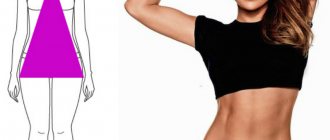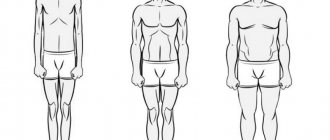Sometimes you feel the desire to start leading a healthy lifestyle, playing sports and eating healthy. This is something akin to the desire to start learning English. This happens especially often at the beginning of the year. It seems that such a moment has come in your life.
We won't go deep into diets. This is not our part. But we can give a specific answer to a specific question - how to count calories and in general, how much is one calorie?
Daily calorie intake
First, let's talk about what it means to say "you should eat a certain number of calories per day."
This refers to the ideal amount of calories, which depends on many factors (they are outlined below). How many calories to consume is your personal decision, and not at all a reflection of a person’s intelligence or value as an individual. You can and should do whatever you want with your body. This article is a simple guide for people who may need help achieving certain goals.
But if you are suffering from an eating disorder, you should talk to your doctor to find out which food is best and healthiest for you, taking into account all the calories, nutrients and food you need. Perhaps in your case you won’t have to think about calories at all. Again: this is very individual.
How to choose the right formula for calculation
To understand how calories are calculated, you need to know two things:
- where do they come from;
- and where are they spent?
The first is very clear - from food. The second point is somewhat more complicated. Our body performs a huge number of actions every day. Is there a calculator that can count them all? We move or sit still, work or rest, but we waste energy. After all, our body works even when we sleep.
When calculating your daily calorie intake, every little detail is important. Whether it's a piece of butter in porridge or a spoon of mayonnaise in a salad. Your lifestyle is equally important. With physical activity, calorie expenditure increases.
Excessive consumption leads to weight gain. But you can't go crazy while losing weight. A lack of energy will lead to the body looking for new sources. Muscle tissue may be damaged. After all, it is this that our body begins to “eat” if we sharply reduce the number of calories consumed. Refusal to eat causes muscle to melt, not fat.
So you need to calculate your norm. And don’t forget to recalculate it if your lifestyle changes.

I’m telling you this, and you may think that there are no other opinions. But John Briffa thinks a little differently. The author of the book “Stop Counting Calories” believes that simply counting your daily calorie intake will not yield results. After all, you need to live “in union with your own body, and not in struggle with it.”
How many calories should you eat per day?
So. If you want to figure out how many calories you need to eat, you should start by determining your basal metabolic rate.
Basal metabolic rate (BMR)
This is NOT the number of calories you should eat in a day! This is how many calories your body burns when you lie in bed without doing anything or eating for 12 hours. This is the minimum amount of calories your body needs just to survive: mainly to keep your internal organs functioning (most people tend to be a little more active, so they need to eat more; more on this below).
There are several ways to calculate your basal metabolic rate, but most experts prefer the Mifflin-St equation. Jeor. This equation takes into account gender, age, weight and height. Unfortunately, it is unclear how this equation might apply to transsexuals who have undergone surgical gender reassignment.
Here's the equation for men:
Basal metabolic rate = 10 x weight (in kilograms) + 6.25 x height (in centimeters) - 5 x age (in years) + 5
And here's the equation for women:
Basal metabolic rate = 10 x weight (in kilograms) + 6.25 x height (in centimeters) - 5 x age (in years) - 161
Once you've determined your basal metabolic rate, you need to figure out how many extra calories you need each day (based on your activity level).
Total energy consumption
The total number of calories you spend each day (on basic functions, getting around, and doing work) is called total energy expenditure. This number tells you how much you need to eat.
The more active you are, the more calories you need daily. To calculate this figure, you need to multiply your basal metabolic rate by a certain number that corresponds to your level of activity. These are the indicators:
- sedentary lifestyle (little or no physical activity) = SMR x 1.2
- lightly active (light exercise/sport 1-3 days per week) = SRR x 1.375
- moderately active (moderate physical activity/sport 3-5 days a week) = SD x 1.55
- very active (strength exercises/sports 6-7 days a week) = SVR x 1.725
- excessive activity (very heavy exercise/sport and physical work or combined training) = SV x 1.9
And again we get a lot of incomprehensible numbers!
Once you've calculated how many calories you need each day, think about your goals.
Methods for calculating the required calories
There are different formulas (principles) of calculation.
- The Harris-Benedict formula (also called the Harris-Benedict principle) is a popular method used to estimate what is called basal metabolic rate (BMR) and daily calorie needs. The resulting number is the recommended daily amount of calories to maintain your current body weight. Nowadays it is considered a little outdated due to changes in the lifestyle of modern people.
- The Muffin-Jeor BMR is a more modern equation that is supposedly 5% more accurate. This is due to the fact that lifestyle has changed even since the last adjustment to the previous formula. But accuracy is maintained here when calculating the basal metabolic rate without taking into account physical activity. When they are present, it is difficult to say which formula will give more accurate results.
- The Ketch-McArdle formula - unlike the previous two formulas, it does not directly take into account weight, height and age, but only muscle mass in kg. According to the results of recent studies, it is muscle mass that influences the difference in the required number of calories for different people, with the other basic parameters being the same.
It looks like this:
P=370+(21.6xLBM), where LBM is muscle mass in kg.
This formula is not shown in the calculator below.
Story. The Harris-Benedict equation originated from the research of James Arthur Harris and Francis Gnao Benedict. Its results were published in 1919 at the Carnegie Institution in Washington. It was edited for accuracy in 1984. Then Dr. Muffin-Geor published an adjusted version of it more suitable for the modern lifestyle in 1990, taking into account the statistics of changes in lean body mass and a greater amount of intellectual work. Historically, this formula has become the most popular.
Source: https://en.wikipedia.org/wiki/Basal_metabolic_rate
Daily calorie requirement calculator
What are your goals?
Of course, everything is much more complicated, but here are some general rules:
- To stay at the same weight, eat the same number of calories as you burn.
- To gain weight, eat more calories than you burn.
- To lose weight, eat fewer calories than you burn.
How much more or how much less? 500 g is approximately 3500 calories. So, to gain a pound, you must eat 3,500 calories more than you expend, and to lose 500 grams, you must eat 3,500 fewer calories than you typically expend.
How many calories does it take to gain weight?
If you want to gain weight, you should talk to your doctor or nutritionist to explain how to do it correctly and safely.

How many calories do you need per day to lose weight?

If your goal is to gain muscle mass, then the amount of macronutrients in the foods you eat is just as important as the number of calories in your diet. Drinking milkshakes all day long will help you gain weight, but it won't make you feel very good.
And if you want to lose weight, then the best thing to do is to strive to lose no more than 0.5-1 kg per week.
And since 500g = 3500 calories, then to lose a pound per week you must have a weekly deficit of 3500 calories. This means you need to eat 3,500 fewer calories per week than usual.
You can achieve this by setting a 500-calorie deficit each day (that is, burning 500 calories more than you eat) or reducing the nutritional value of your daily diet by 300 calories and increasing your workout caloric expenditure by 200 calories.
SO HERE. Everything written above is the basic principles for counting daily calories. But you should know: these data are very approximate. The number of calories may vary depending on many facts.
How to understand and measure calories
One calorie is the amount of energy required to heat one liter of water by one degree Celsius. But in the USA they also count calories, although they measure degrees in Fahrenheit. If you convert 1 kcal to Joules, you get 4.2 kJ. One might wonder how a calorie differs from a kilocalorie. In fact, 1 kk is a thousand times more than 1 k. But often these words are not distinguished. We are used to measuring calories in kcal, but often kilocalories are simply called calories.
This still doesn't mean much to the average person. It’s easier to imagine something more earthly, everyday, understandable. Here is a small table of the approximate calorie content of various foods:
- Large chicken egg - 78
- A glass of low-fat milk - 103
- Ripe banana – 110
- Buckwheat (100 g) – 343
Now you can roughly imagine that one hundred calories is approximately the same as a banana or a glass of milk.

How to find out the calorie content of a product
In stores, calorie content is written on the packages. In restaurants, it is often written in a discreet font next to the dish, next to the weight. When you cook at home yourself, you can use a calculator. Look at the energy value of ready-made meals on websites about healthy eating, or better yet, for convenience, download the app - a calorie calculator. All the main dishes are already calculated there, and you can also save templates there, so that you don’t have to recalculate the dishes each time according to your own recipes. Over time, you will remember the calorie content of individual foods and learn to count it in your head.
True, this is not enough. The balance of proteins, fats and carbohydrates is also of great importance. Different elements are absorbed by the body in different ways. But that's a completely different story.
How many calories does a person need?

Counting calories involves almost all diets, so now you can easily find the calorie content not only of individual ingredients, but also of even the most complex dishes. Each person has his own minimum number of calories that should be consumed daily.
Diets based on calorie counting do not have strict restrictions on food choice: you can consume a wide variety of foods. An interesting fact is that by overeating by only 100 kcal daily, a person will gain about 5 kg in weight over the course of a year.
How many calories should you consume?
Initially, it is necessary to calculate the calorie indicator that the body needs to consume depending on gender, age and even height:
Table 1 - Daily kcal intake for men and women
How many calories should you burn?
Energy consumption by the body occurs constantly: a person expends kilocalories when walking, cleaning, watching TV. Even washing windows within an hour can use up to 100 kcal. Nutritionists have found that to lose 1 kg a person must spend 7,700 kcal in 2 weeks. How many calories does a person need?
Many people mistakenly cut their daily diet in half to lose weight. To lose weight, you need to gradually increase your daily energy expenditure by doing physical exercise.
How many calories does an athlete need?
Athletes expend more energy than people leading a passive lifestyle, so the calorie content of their diet should be increased by up to 1.5 times. The daily norm also depends on the type of sport: athletics requires endurance, so the need for kilocalories for these athletes reaches up to 44 units per 1 kg of weight.
Before competitions and tournaments, the load increases, the number of training increases, which means an increase in the consumed diet.
Ketch-McArdle formula
The Ketch-McArdle formula will help you determine the recommended amount of calories and adjust your diet to scientific data. It is based on body fat percentage.
It is worth mentioning right away that not everyone should use this option, since it is based on taking into account lean muscle mass, and not on weight. The energy spent per day is not taken into account here at all. That is why obese people will not be able to achieve accuracy and adjust their diet according to the recommendations.
Data is obtained according to a single scheme for men and women.
The result is calculated as follows: 370 + (21.6 x body weight in kg)










